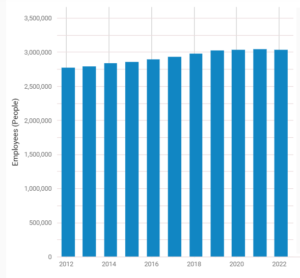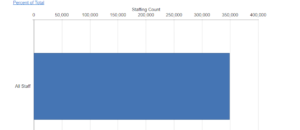Primary, secondary, and higher education institutions employ over 11 million people nationwide and provide educational services to many more students. At a national level, more than 8 million people are employed by primary and secondary schools. (See Bureau of Labor Statistics, May 2021.) Another over 3 million people are employed by colleges and universities in the United States. (See IBIS World at https://www.ibisworld.com/industry-statistics/employment/colleges-universities-united-states/)

According to MiSchoolData, there are currently 350,000 individuals employed by primary and secondary schools or related educational entities in the state (see below).

Primary, secondary, and higher education institutions are tasked with establishing Title IX policies and implementing Title IX procedures so that policies and procedures are in place when a student or employee raises allegation of sexual discrimination or harassment. As employers with millions of employees and even more students, Title IX claims are frequent and increasing.
Brief History of Title IX
On June 23, 1972, President Nixon signed the Education Amendments Act of 1972. Title IX of the Act has become one of the most important, yet contested, federal protections of students’ civil rights and educational opportunities. It reads:
No person in the United States shall, on the basis of sex, be excluded from participation in, be denied the benefits of, or be subjected to discrimination under any education program or activity receiving Federal financial assistance.
Title IX prohibits sex discrimination at educational institutions that receive federal funding in primary, secondary, and higher education. Although the statute is short, the Supreme Court and U.S. Department of Education have solidified its broad scope, including its purview over sexual assault and harassment on school campuses. According to the Education Department, Title IX applies to about 17,600 local school districts, more than 5,000 postsecondary institutions, charter schools, for-profit schools, libraries and museums. It covers both students and employees.
When people hear a reference to Title IX, their thoughts typically go to the 1972 law that required high school and college athletics programs to offer equal opportunities for women. However, Title IX protects students (and employees) in other critical ways. Title IX prevents gender-based violence and harassment – including sexual harassment, rape, sexual assault, and bullying or harassment based on stereotypes about how boys and girls ought to look or behave, and sets forth mandatory investigation and decision-making requirements.
The Evolution of Title IX
The how, what, when, where, and by whom criteria for Title IX investigations is subject to regulations issued by the U.S. Department of Education. The prior Administration implemented sweeping changes in 2020 to the Title IX requirements that were subject to heated debate. We are now facing another overhaul to Title IX regulations.
On June 23, 2022, the U.S. Department of Education, under the Biden Administration, released its proposed changes to Title IX regulations for public comment. The Biden administration says the changes would restore protections from sexual harassment and assault and sex-based discrimination, including for LGBTQI+ students who confront discrimination based on their sexual orientation or gender identity. Its proposed amendments would reverse many changes made by the Trump administration.
Takeaways of New Proposed Changes to Title IX
Here are quick takeaways of some of the most important changes to Title IX in the proposed regulations:
- Broaden the Definition of Sexual Harassment
In several ways, the proposed regulations make significant changes that broaden the protections of Title IX:
- The proposed regulations also make clear that sex-based discrimination covered by Title IX includes discrimination based on sex stereotypes, sex characteristics, pregnancy or related conditions, sexual orientation, and gender identity.
- The proposed regulations make significant changes to what will be known as “sex-based harassment” that broaden the definition of quid pro quo harassment and broaden the definition for “hostile environment harassment” to, among other things, reach conduct that is “severe or pervasive” rather than “severe and pervasive.”
- Expand Implications of Off-Campus Conduct
The regulations would require colleges and universities to address off-campus conduct that contributes to a hostile environment.
- The proposed regulations would revive the Obama-era guidance requiring institutions to investigate misconduct occurring off-campus.
- Specifically, institutions would have an obligation to address sex-based harassment even if the harassment occurred outside the institution’s program or activity, meaning at off-campus locations not under institutional control.
- The proposed regulations go further than the Obama-era guidance in imposing an obligation to investigate when harassment occurs outside the United States.
- Prohibit Exclusion Based on Gender Identity
The regulations would prohibit exclusion from programs based on gender identity—but leave open questions about sports.
- The regulations would prohibit institutions from excluding students from clubs, activities, facilities, or the like based on gender identity.
- However, the proposed regulations defer setting forth what criteria schools may use to establish eligibility to participate on a male or female athletic team. The Department of Education will address Title IX’s application to athletics in a separate rulemaking.
- Define All Employees as “Mandatory Reporters”
The proposed regulations specifically define which employees are required to report to the Title IX Coordinator allegations of potential sexual harassment of which they become aware.
- Under the proposed regulations, allegations that a student may have been subjected to sex discrimination under Title IX must be reported to the Title IX Coordinator by not only anyone who has the authority to institute corrective measures but also by any employee (who is not a confidential employee) who has responsibility for “administrative leadership, teaching or advising.”
- If employees with responsibility for “administrative leadership, teaching or advising” (who are not confidential employees) have information about an employee of the institution having been subjected to sex discrimination under Title IX, they must either report such allegations to the Title IX Coordinator or share with the person who told them about the possible discrimination the contact information for the Title IX Coordinator and how to file a complaint.
- All other employees (who are not confidential employees) with information that either a student or employee has been subjected to potential sex discrimination under Title IX must either report such allegations to the Title IX Coordinator or share them with the person who told them about the possible discrimination the contact information for the Title IX Coordinator and how to file a complaint.
- Provide More Flexibility in the Decision Process on Complaints, Including Removing the Requirement for Live Hearings and Cross-examination
The proposed regulations give education institutions more flexibility in the processes used to make determinations on complaints of sex discrimination under Title IX.
- The decision maker may be the Title IX Coordinator or the investigator (i.e., institutions may re-institute the single investigator model).
- Parties must be given access to all the relevant evidence or an investigative report that summarizes the relevant evidence.
- If the parties are provided an investigative report, they must also be provided access to the evidence if either party requests it.
- Parties must be allowed to respond to the evidence before a decision is made on the allegations, but it is up to the institution to determine just when and how that response is obtained (in writing, at a hearing, etc.).
- Education institutions must employ a process that allows the decision maker to adequately assess the credibility of parties and witnesses to the extent that credibility is both in dispute and relevant to the allegations. That process may take different forms.
- The decision maker may ask questions either at a live hearing or in individual meetings with parties. The parties may propose to the decision maker or investigator questions that they would like to have asked and follow-up questions, including questions challenging credibility. The decision maker must ask questions provided by parties as long as relevant and not otherwise impermissible, except that a higher education institution must not ask questions that are unclear or harassing to the party being questioned.
- If the institution elects to have a live hearing, it may allow advisors for the parties to question the other party and witnesses. If there is a live hearing and a party does not have an advisor, the institution must provide an advisor who may or may not be an attorney.
- The proposed regulations allow the decision maker’s report on whether sex-based harassment occurred to be more streamlined than the current regulations allow.
- Allow a Different Process for Complaints Where Only Employees Are Parties
The proposed regulations have a separate section for the process required for higher education institutions to use where there is a student complainant or respondent. Where only employees are involved in alleged sex discrimination under Title IX, higher education institutions can use more streamlined procedures (which may be used by K-12 institutions for all complaints).
- Parties must be provided a description of the evidence (but not the evidence itself) and a “reasonable opportunity” to respond.
- The process must allow decision makers to adequately assess the credibility of parties and witnesses to the extent that credibility is in dispute and relevant, but the regulations do not specify how that must be done.
- The decision maker’s report on whether sex-based harassment occurred can be much streamlined from what the current regulations require.
- Expand the Boundaries of Supportive Measures
The proposed regulations would allow greater burdens on respondents where necessary to provide complainants with access to programs while a complaint is pending.
- The proposed regulations define supportive measures to include “temporary measures” that may burden a respondent if the measures are temporary and are designed to protect the safety of the complainant or the institution’s educational environment or deter the respondent from engaging in sex-based harassment.
- The new regulations clarify that supportive measures may include “voluntary or involuntary changes in class, work, housing or extracurricular or any other activity, regardless of whether there is or is not a comparable alternative.”
- Any supportive measures that burden a respondent may only be in place during the pendency of a complaint.
- An educational institution must provide a party with the ability to obtain a timely review of the imposition of supportive measures by “an appropriate, impartial employee.”
If you have any questions about the above or about Title IX, please do not hesitate to contact the author.
Related Services:
 About the Author: Aimee R. Gibbs in a Member in the firm’s Ann Arbor office where she handles a wide range of legal services for clients, including, policy formation, risk-mitigation, regulatory compliance, employment counseling and litigation and commercial litigation. She can be reached at 734-623-1653 or via email at AGibbs@dickinsonwright.com.
About the Author: Aimee R. Gibbs in a Member in the firm’s Ann Arbor office where she handles a wide range of legal services for clients, including, policy formation, risk-mitigation, regulatory compliance, employment counseling and litigation and commercial litigation. She can be reached at 734-623-1653 or via email at AGibbs@dickinsonwright.com.
